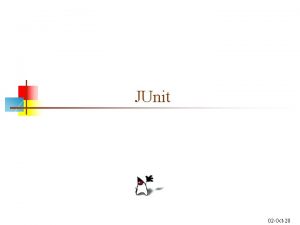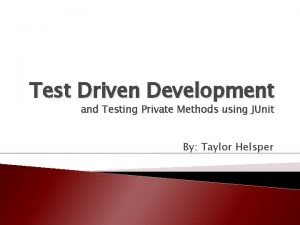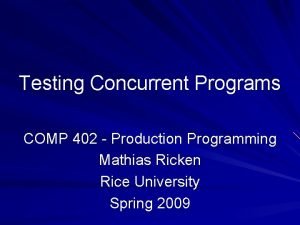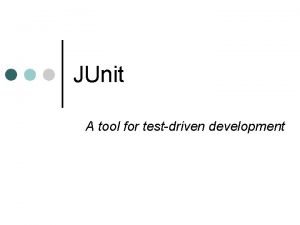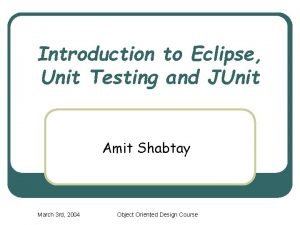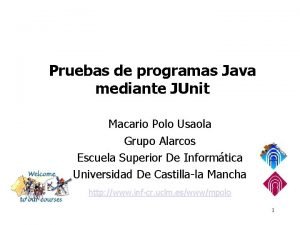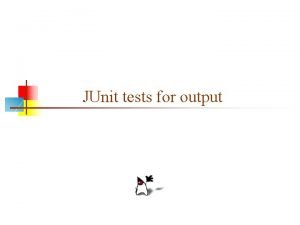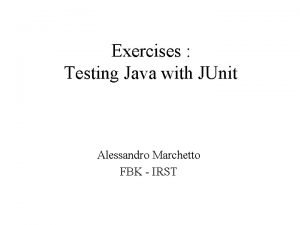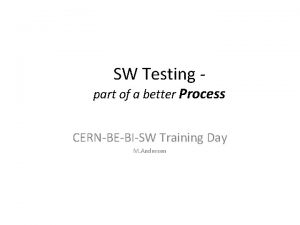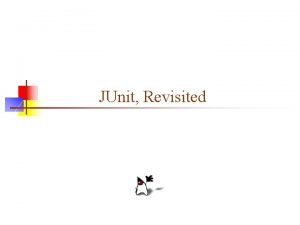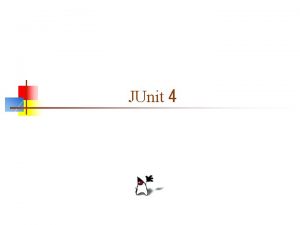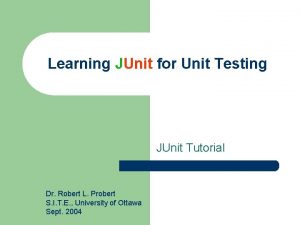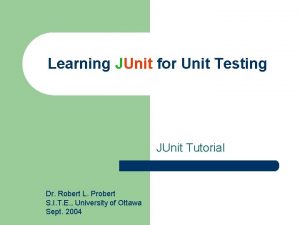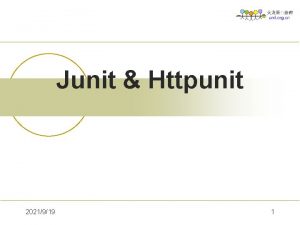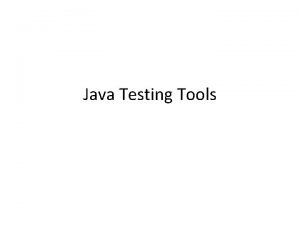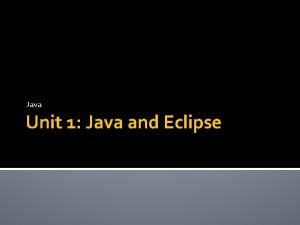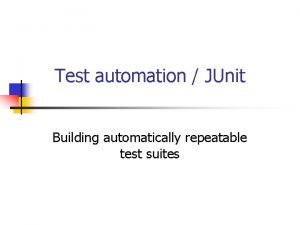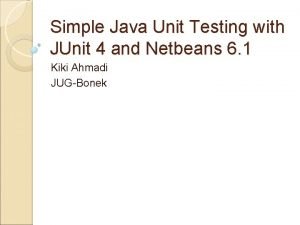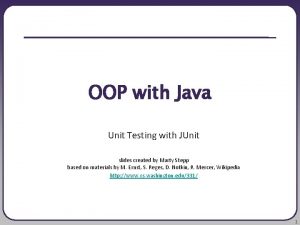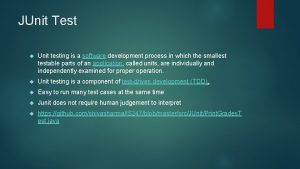JUnit A unit test framework for Java Authors































- Slides: 31

JUnit • A unit test framework for Java – Authors: Erich Gamma, Kent Beck • Objective: – “If tests are simple to create and execute, then programmers will be more inclined to create and execute tests. ” © Dr. A. Williams, Fall 2008 - Present 1

Introduction • What do we need to do automated testing? – Test script – Actions to send to system under test (SUT). – Responses expected from SUT. – How to determine whether a test was successful or not? – Test execution system – Mechanism to read test scripts, and connect test case to SUT. – Keeps track of test results. © Dr. A. Williams, Fall 2008 - Present 2

Test case verdicts • A verdict is the declared result of executing a single test. • Pass: the test case achieved its intended purpose, and the software under test performed as expected. • Fail: the test case achieved its intended purpose, but the software under test did not perform as expected. • Error: the test case did not achieve its intended purpose. – Potential reasons: – An unexpected event occurred during the test case. – The test case could not be set up properly © Dr. A. Williams, Fall 2008 - Present 3

A note on JUnit versions. . . • The current version is 4. 3. 1, available from Mar. 2007 – To use JUnit 4. x, you must use Java version 5 or 6 • JUnit 4, introduced April 2006, is a significant (i. e. not compatible) change from prior versions. • JUnit 4 is used in this presentation. • Much of the JUnit documentation and examples currently available are for JUnit 3, which is slightly different. – JUnit 3 can be used with earlier versions of Java (such as 1. 4. 2). – The junit. org web site shows JUnit version 4 unless you ask for the old version. – Eclipse (3. 2) gives the option of using JUnit 3. 8 or JUnit 4. 1, which are both packaged within Eclipse. © Dr. A. Williams, Fall 2008 - Present 4

What is a JUnit Test? • A test “script” is just a collection of Java methods. – General idea is to create a few Java objects, do something interesting with them, and then determine if the objects have the correct properties. • What is added? Assertions. – A package of methods that checks for various properties: – “equality” of objects – identical object references – null / non-null object references – The assertions are used to determine the test case verdict. © Dr. A. Williams, Fall 2008 - Present 5

When is JUnit appropriate? • As the name implies… – for unit testing of small amounts of code • On its own, it is not intended for complex testing, system testing, etc. • In the test-driven development methodology, a JUnit test should be written first (before any code), and executed. – Then, implementation code should be written that would be the minimum code required to get the test to pass – and no extra functionality. – Once the code is written, re-execute the test and it should pass. – Every time new code is added, re-execute all tests again to be sure nothing gets broken. © Dr. A. Williams, Fall 2008 - Present 6

A JUnit 4 Test Case /** Test of set. Name() method, of class Value */ @Test public void create. And. Set. Name() { Value v 1 = new Value( ); v 1. set. Name( "Y" ); String expected = "Y"; String actual = v 1. get. Name( ); Assert. assert. Equals( expected, actual ); } © Dr. A. Williams, Fall 2008 - Present 7

A JUnit 4 Test Case /** Test of set. Name() method, of class Value */ Identifies this Java method @Test public void create. And. Set. Name() as a test case, for the test runner { Value v 1 = new Value( ); v 1. set. Name( "Y" ); String expected = "Y"; String actual = v 1. get. Name( ); Assert. assert. Equals( expected, actual ); } © Dr. A. Williams, Fall 2008 - Present 8

A JUnit 4 Test Case /** Test of set. Name() method, of class Value */ @Test public void create. And. Set. Name() { Value v 1 = new Value( ); v 1. set. Name( "Y" ); Objective: confirm that set. Name saves the specified name in the Value object String expected = "Y"; String actual = v 1. get. Name( ); Assert. assert. Equals( expected, actual ); } © Dr. A. Williams, Fall 2008 - Present 9

A JUnit 4 Test Case /** Test of set. Name() method, of class Value @Test public void create. And. Set. Name() { Value v 1 = new Value( ); v 1. set. Name( "Y" ); */ Check to see that the Value object really did store the name String expected = "Y" String actual = v 1. get. Name( ); Assert. assert. Equals( expected, actual ); } © Dr. A. Williams, Fall 2008 - Present 10

A JUnit 4 Test Case /** Test of set. Name() method, of class Value @Test public void create. And. Set. Name() { Value v 1 = new Value( ); v 1. set. Name( "Y" ); */ We want expected and actual to be equal. If they aren’t, then the test case should fail. String expected = "Y"; String actual = v 1. get. Name( ); Assert. assert. Equals( expected, actual ); } © Dr. A. Williams, Fall 2008 - Present 11

Assertions • Assertions are defined in the JUnit class Assert – If an assertion is true, the method continues executing. – If any assertion is false, the method stops executing at that point, and the result for the test case will be fail. – If any other exception is thrown during the method, the result for the test case will be error. – If no assertions were violated for the entire method, the test case will pass. • All assertion methods are static methods © Dr. A. Williams, Fall 2008 - Present 12

Assertion methods (1) • Boolean conditions are true or false assert. True(condition) assert. False(condition) • Objects are null or non-null assert. Null(object) assert. Not. Null(object) • Objects are identical (i. e. two references to the same object), or not identical. assert. Same(expected, actual) – true if: expected == actual assert. Not. Same(expected, actual) © Dr. A. Williams, Fall 2008 - Present 13

Assertion methods (2) • “Equality” of objects: assert. Equals(expected, actual) – valid if: expected. equals( actual ) • “Equality” of arrays: assert. Array. Equals(expected, actual) – arrays must have same length – for each valid value for i, check as appropriate: assert. Equals(expected[i], actual[i]) or assert. Array. Equals(expected[i], actual[i]) • There is also an unconditional failure assertion fail() that © Dr. always A. Williams, results in a fail verdict. 14 Fall 2008 - Present

Assertion method parameters • In any assertion method with two parameters, the first parameter is the expected value, and the second parameter should be the actual value. – This does not affect the comparison, but this ordering is assumed for creating the failure message to the user. • Any assertion method can have an additional String parameter as the first parameter. The string will be included in the failure message if the assertion fails. – Examples: fail( message ) assert. Equals( message, expected, actual) © Dr. A. Williams, Fall 2008 - Present 15

Equality assertions • assert. Equals(a, b) relies on the equals() method of the class under test. – The effect is to evaluate a. equals( b ). – It is up to the class under test to determine a suitable equality relation. JUnit uses whatever is available. – Any class under test that does not override the equals() method from class Object will get the default equals() behaviour – that is, object identity. • If a and b are of a primitive type such as int, boolean, etc. , then the following is done for assert. Equals(a, b) : – a and b are converted to their equivalent object type (Integer, Boolean, etc. ), and then a. equals( b ) is evaluated. © Dr. A. Williams, Fall 2008 - Present 16

Floating point assertions • When comparing floating point types (double or float), there is an additional required parameter delta. • The assertion evaluates Math. abs( expected – actual ) <= delta to avoid problems with round-off errors with floating point comparisons. • Example: assert. Equals( a. Double, another. Double, 0. 0001 ) © Dr. A. Williams, Fall 2008 - Present 17

Organization of JUnit tests • Each method represents a single test case that can independently have a verdict (pass, error, fail). • Normally, all the tests for one Java class are grouped together into a separate class. – Naming convention: – Class to be tested: Value – Class containing tests: Value. Test © Dr. A. Williams, Fall 2008 - Present 18

Running JUnit Tests (1) • The JUnit framework does not provide a graphical test runner. Instead, it provides an API that can be used by IDEs to run test cases and a textual runner than can be used from a command line. • Eclipse and Netbeans each provide a graphical test runner that is integrated into their respective environments. © Dr. A. Williams, Fall 2008 - Present 19

Running JUnit tests (2) • With the runner provided by JUnit: – When a class is selected for execution, all the test case methods in the class will be run. – The order in which the methods in the class are called (i. e. the order of test case execution) is not predictable. • Test runners provided by IDEs may allow the user to select particular methods, or to set the order of execution. • It is good practice to write tests with are independent of execution order, and that are without dependencies on the state any previous test(s). © Dr. A. Williams, Fall 2008 - Present 20

Test fixtures • A test fixture is the context in which a test case runs. • Typically, test fixtures include: – Objects or resources that are available for use by any test case. – Activities required to make these objects available and/or resource allocation and deallocation: “setup” and “teardown”. © Dr. A. Williams, Fall 2008 - Present 21

Setup and Teardown • For a collection of tests for a particular class, there are often some repeated tasks that must be done prior to each test case. – Examples: create some “interesting” objects to work with, open a network connection, etc. • Likewise, at the end of each test case, there may be repeated tasks to clean up after test execution. – Ensures resources are released, test system is in known state for next test case, etc. – Since a test case failure ends execution of a test method at that point, code to clean up cannot be at the end of the method. © Dr. A. Williams, Fall 2008 - Present 22

Setup and Teardown • Setup: – Use the @Before annotation on a method containing code to run before each test case. • Teardown (regardless of the verdict): – Use the @After annotation on a method containing code to run after each test case. – These methods will run even if exceptions are thrown in the test case or an assertion fails. • It is allowed to have any number of these annotations. – All methods annotated with @Before will be run before each test case, but they may be run in any order. © Dr. A. Williams, Fall 2008 - Present 23

Example: Using a file as a text fixture public class Output. Test { private File output; @Before public void create. Output. File() { output = new File(. . . ); } @After public void delete. Output. File() { output. delete(); } @Test public void test 1 With. File() { // code for test case objective } @Test public void test 2 With. File() { // code for test case objective © Dr. A. Williams, } - Present Fall 2008 } 24

Method execution order 1. create. Output. File() 2. test 1 With. File() 3. delete. Output. File() 4. create. Output. File() 5. test 2 With. File() 6. delete. Output. File() • Assumption: test 1 With. File runs before test 2 With. File– which is not guaranteed. © Dr. A. Williams, Fall 2008 - Present 25

Once-only setup • It is also possible to run a method once only for the entire test class, before any of the tests are executed, and prior to any @Before method(s). • Useful for starting servers, opening communications, etc. that are time-consuming to close and re-open for each test. • Indicate with @Before. Class annotation (can only be used on one method, which must be static): @Before. Class public static void any. Name. Here() { // class setup code here } © Dr. A. Williams, Fall 2008 - Present 26

Once-only tear down • A corresponding once-only cleanup method is also available. It is run after all test case methods in the class have been executed, and after any @After methods • Useful for stopping servers, closing communication links, etc. • Indicate with @After. Class annotation (can only be used on one method, which must be static): @After. Class public static void any. Name. Here() { // class cleanup code here } © Dr. A. Williams, Fall 2008 - Present 27

Exception testing (1) • Add parameter to @Test annotation, indicating that a particular class of exception is expected to occur during the test. @Test(expected=Excepted. Type. Of. Exception. class) public void test. Exception() { exception. Causing. Method(); } • If no exception is thrown, or an unexpected exception occurs, the test will fail. – That is, reaching the end of the method with no exception will cause a test case failure. • Testing contents of the exception message, or limiting the scope of where the exception is expected requires using the approach on the next slide. © Dr. A. Williams, Fall 2008 - Present 28

Exception testing (2) • Catch exception, and use fail( ) if not thrown public void test. Exception() { try { exception. Causing. Method(); // If this point is reached, the expected // exception was not thrown. fail("Exception should have occurred"); } } catch ( Excepted. Type. Of. Exception exc ) { String expected = "A suitable error message"; String actual = exc. get. Message(); Assert. assert. Equals( expected, actual ); } © Dr. A. Williams, Fall 2008 - Present 29

JUnit 3 • At this point, migration is still underway from JUnit 3 to JUnit 4 – Eclipse 3. 2 has both – The Eclipse test and performance tools platform does not yet work with JUnit 4. – Netbeans 5. 5 has only JUnit 3. • Within the JUnit archive, the following packages are used so that the two versions can co-exist. – JUnit 3: junit. framework. * – JUnit 4: org. junit. * © Dr. A. Williams, Fall 2008 - Present 30

Topics for another day. . . • Differences between JUnit 3 and JUnit 4 • More on test runners • Parameterized tests • Tests with timeouts • Test suites © Dr. A. Williams, Fall 2008 - Present 31
 тест кейс пример
тест кейс пример Junit test fixture
Junit test fixture Junit testing private methods
Junit testing private methods Junit test concurrency
Junit test concurrency Unit 10, unit 10 review tests, unit 10 general test
Unit 10, unit 10 review tests, unit 10 general test Junit vogella
Junit vogella Junit history
Junit history Junit tutorial eclipse
Junit tutorial eclipse Junit
Junit Junit testing
Junit testing Junit exercises
Junit exercises Tdd junit
Tdd junit Informatica def
Informatica def Unit test algebra 2
Unit test algebra 2 C++ unit test framework
C++ unit test framework Unit 4 lesson 7 right triangles and trigonometry unit test
Unit 4 lesson 7 right triangles and trigonometry unit test Iso 22301 utbildning
Iso 22301 utbildning Typiska novell drag
Typiska novell drag Nationell inriktning för artificiell intelligens
Nationell inriktning för artificiell intelligens Returpilarna
Returpilarna Varför kallas perioden 1918-1939 för mellankrigstiden?
Varför kallas perioden 1918-1939 för mellankrigstiden? En lathund för arbete med kontinuitetshantering
En lathund för arbete med kontinuitetshantering Adressändring ideell förening
Adressändring ideell förening Vilotidsbok
Vilotidsbok Sura för anatom
Sura för anatom Förklara densitet för barn
Förklara densitet för barn Datorkunskap för nybörjare
Datorkunskap för nybörjare Tack för att ni lyssnade bild
Tack för att ni lyssnade bild Debattinlägg mall
Debattinlägg mall Delegerande ledarskap
Delegerande ledarskap Nyckelkompetenser för livslångt lärande
Nyckelkompetenser för livslångt lärande Påbyggnader för flakfordon
Påbyggnader för flakfordon

